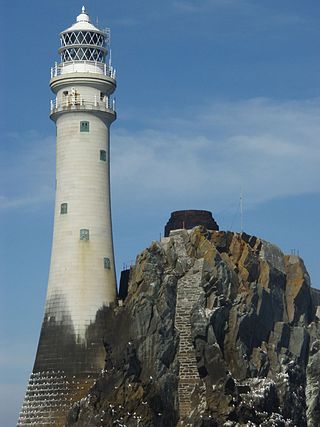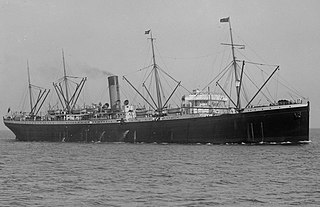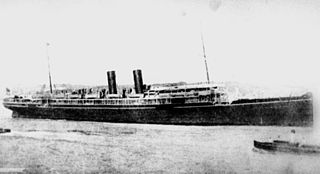
Longships Lighthouse is an active 19th-century lighthouse about 1.25 mi (2.0 km) off the coast of Land's End in Cornwall, England. It is the second lighthouse to be built on Carn Bras, the highest of the Longships islets which rises 39 feet (12 m) above high water level. In 1988 the lighthouse was automated, and the keepers withdrawn. It is now remotely monitored from the Trinity House Operations & Planning Centre in Harwich, Essex.

Fastnet Lighthouse is a 54-metre-tall (177 ft) lighthouse situated on the remote Fastnet Rock in the Atlantic Ocean. It is the most southerly point of Ireland and lies 6.5 kilometres (4.0 mi) southwest of Cape Clear Island and 13 kilometres (8.1 mi) from County Cork on the Irish mainland. The current lighthouse is the second to be built on the rock and is the tallest in Ireland.

SS Schiller was a 3,421-ton German ocean liner, one of the largest vessels of her time. Launched in 1873, she plied her trade across the Atlantic Ocean, carrying passengers between New York City and Hamburg for the German Transatlantic Steam Navigation Line. She became notorious on 7 May 1875, while operating on her normal route, when she hit the Retarrier Ledges in the Isles of Scilly, causing her to sink with the loss of most of her crew and passengers, totaling 335 fatalities.
Graveyard of the Atlantic is a nickname for the treacherous waters and area of numerous shipwrecks off the Outer Banks of North Carolina, United States, which are due to the coast's shifting sands and inlets. To a lesser degree, this nickname has also been applied to Sable Island off of Nova Scotia, Canada, as well as the waters off Cape Cod, Massachusetts, United States.

SS Valencia was an iron-hulled passenger steamer built for the Red D Line for service between Venezuela and New York City. She was built in 1882 by William Cramp and Sons, one year after the construction of her sister ship Caracas. She was a 1,598-ton vessel, 252 feet (77 m) in length. In 1897, Valencia was deliberately attacked by the Spanish cruiser Reina Mercedes off Guantanamo Bay, Cuba. The next year, she became a coastal passenger liner on the U.S. West Coast and served periodically in the Spanish–American War as a troopship to the Philippines. Valencia was wrecked off Cape Beale, which is near Clo-oose, on the west coast of Vancouver Island, British Columbia, on 22 January 1906. As her sinking killed 100 people, some classify the wreck of Valencia as the worst maritime disaster in the "Graveyard of the Pacific", a famously treacherous area off the southwest coast of Vancouver Island.

PS Queen Victoria was a paddle steamer built for the City of Dublin Steam Packet Company in 1838 and wrecked in 1853 with the loss of more than 80 passengers and crew.

Tuskar Rock is a group of rocks topped by a lighthouse 11 kilometres off the southeast coast of County Wexford, Ireland. The rocks have probably destroyed more ships than any other Irish coastal feature. One hundred and seventy-six wrecks are listed for the Tuskar Rock area at Irish Wrecks Online.

SS Suevic was a steamship built by Harland and Wolff in Belfast for the White Star Line. Suevic was the fifth and last of the Jubilee-class ocean liners, built specifically to service the Liverpool-Cape Town-Sydney route, along with her sister ship Runic. In 1907 she was wrecked off the south coast of England, but in the largest rescue of its kind, all passengers and crew were saved. The ship herself was deliberately broken in two, and a new bow was attached to the salvaged stern portion. Later serving as a Norwegian whaling factory ship carrying the name Skytteren, she was scuttled off the Swedish coast in 1942 to prevent her capture by ships of Nazi Germany.
Two Friends was a medium-sized wooden sailing ship that served the British government for transporting troops to garrisons across the British Empire during the Napoleonic Wars. On 22 October 1805 Two Friends was wrecked on the coast of Cape Breton Island with the loss of three lives.

The Western Rocks are a group of uninhabited skerries and rocks in the south–western part of the Isles of Scilly, United Kingdom, and are renowned for the numerous shipwrecks in the area and the nearby Bishop Rock lighthouse. In 1971, the rocks and islands were designated a Site of Special Scientific Interest for their breeding sea birds. Landing on the islands is both difficult and discouraged and there are few published records of visits by naturalists.
The French ship Chameau or Le Chameau (Camel) was a wooden sailing ship of the French Navy, built in 1717. She was used to transport passengers and supplies to New France, making several trips. Nearing the end of her last voyage, a storm blew her onto some rocks on August 27, 1725. She sank, with the loss of all aboard; estimates range as high as 316 dead. In 1965, Alex Storm and his associates located the wreckage near Chameau Rock, and recovered a treasure of gold and silver pieces.

SS Egypt was a P&O ocean liner. She sank after a collision with Seine on 20 May 1922 in the Celtic Sea. 252 people were rescued from the 338 passengers and crew aboard at the time. A subsequent salvage operation recovered most of the cargo of gold and silver.

William Douglass was for twenty-six years an engineer for Trinity House and engineer-in-chief to the Commissioners of Irish Lights from 1878 to 1900. He built a number of offshore lighthouses and was responsible for the design of the second Fastnet Rock lighthouse.
SS Sagamore was a transatlantic cargo liner that was built in Ireland in 1892 for George Warren's White Diamond Steam Ship Company. In 1913 she was modified to carry passengers as well as cargo. In 1917 a German U-boat sank her, causing the death of 52 members of her crew.

USLHT Armeria was a lighthouse tender in commission with the United States Lighthouse Board from December 1890 to March 1898. After Spanish–American War service in the United States Navy as USS Armeria from May to August 1898, she resumed her lighthouse tender duties, first with the Lighthouse Board from 1898 to 1910 and then with its successor organization, the United States Lighthouse Service, from 1910 until she was wrecked in 1912. She was the first lighthouse tender assigned to permanent duty in the Territory of Alaska.








